© 2004 Jeff Matthews & napoli.comAround
Naples in English
|
| The bones of St. Andrew, enclosed in three beautifully decorated cases, emanate an extraordinary substance: Manna. |
I don't
know quite what to make of that. Manna is one of the many things I know
very little about, but I had always thought it referred to the substance
mentioned in the 16th chapter of Exodus, the food miraculously supplied
to the Children of Israel during their 40 years of wandering in the
wilderness:
| …and it was like coriander seed, white; and the taste of it was like wafers made with honey... |
My
OED now tells me, however, that "manna" is also
| A sweet pale yellow or whitish concrete juice obtained from incisions in the bark of the Manna-ash, Fraxinus Ornus, chiefly in Calabria and Sicily; used in medicine as a gentle laxative. Also, a similar exudation obtained from other plants. |
I am not sure what all that means. I am irreverently—but briefly—reminded of Mark Twain's comment that Christ had 12 disciples and that 13 of them are buried in Germany. I suppose it is equally irreverent to suppose that the bones of a dead person—even a saint—might provide food for those so inclined. I shall have to let that go for a while.
The item that really caught my attention was the statue of a bird (see photo, above), standing upright, wings outspread, high enough (about five feet) to partially occlude the lectern it was placed in front of. The tour-guide who had known every little thing about every handle and hinge on the bronze doors of the cathedral tried to drag us right by the bird with no comment. I asked. She didn't know. Fine, it happens. No hard feelings, but I had to know.
It was clearly out of place, gray and drab —but totally surrounded by splendor. The first problem was to figure out what kind of bird it was. The wings were no help. They looked angelic and out-of-place on any avian species I remembered—except for that race of Hawk Men in the old Flash Gordon serials from the 1930s.
The
eagle, the symbol of St. John, from the Book of Kells
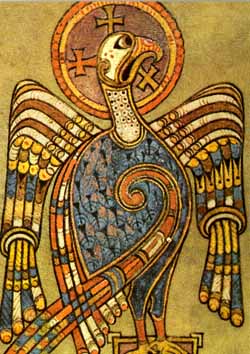 What
birds are symbolic in the Christian faith? That might help. The list
is impressive: the dove, eagle, pelican, stork, crane, swan, and even
the vulture (sometimes allegorized as the purifier of the world and
the vanquisher of the infernal serpent). More obvious is the mythological
phoenix seen as a symbol of Christ and His resurrection. In general,
the flight of the bird represents the soul as opposed to the earthbound
body, and in art there are many depictions of the infant Jesus holding
a bird in his hand, suggesting the idea of the soul incarnated in the
body. There are abundant passages in scripture that mention birds:
What
birds are symbolic in the Christian faith? That might help. The list
is impressive: the dove, eagle, pelican, stork, crane, swan, and even
the vulture (sometimes allegorized as the purifier of the world and
the vanquisher of the infernal serpent). More obvious is the mythological
phoenix seen as a symbol of Christ and His resurrection. In general,
the flight of the bird represents the soul as opposed to the earthbound
body, and in art there are many depictions of the infant Jesus holding
a bird in his hand, suggesting the idea of the soul incarnated in the
body. There are abundant passages in scripture that mention birds:
| —Be
ye therefore wise as serpents and simple as doves. (Matt. 10:16)
—They that wait upon the Lord shall renew their strength; they shall mount up with wings as eagles." (Isa. 40: 31) —As an eagle stirreth up her nest, fluttereth over her young, spreadeth abroad her wings, taketh them, beareth them on her wings; so the Lord alone did lead him." (Deut.32: 10-12) —And the Holy Ghost descended in a bodily shape like a dove upon him...(Luke 3:22) even —The wings of the ostrich flap joyfully, but they cannot compare with the pinions and feathers of the stork. (Job: 39:13) |
And so on. It is very long and complicated list to thresh out for allegorists. The statue in the Amalfi cathedral really didn't look like a dove, which had been my first intuition. An eagle? Maybe. My wife was of the opinion that it looked like some kind of a "stretched chicken".
"Hah. There
are no chickens in Christian symbolism," I said profoundly.
"What about where Jesus says to Peter: 'The cock shall not crow till
thou hast denied me thrice.'?"
"A cock is not a chicken."
"A cock is Mr. Chicken."
A cock is Mr. Chicken. Uxorial hermeneutics can be enlightening at times. Assuming this not to have been one of those times, I put Mr. Chicken on the back-burner with the Hawk Men.
I called the Amalfi archdiocese and spoke to a knowledgeable young man. Indeed, the statue is of an eagle and represents St. John the Evangelist. Every evangelist is represented by an animal. The eagle represents St. John because in his Gospel, St. John sees with the unflinching eye of an eagle the highest truths in the divinity of Christ, the Redeemer. The statue seemed—was—out of place because it had, in fact, been moved to be in front of a lectern in the main part of the church in keeping with this spirit of the Evangelist, the preacher. Originally, the statue had been in the baptistery. The eagle, it seems, is a symbol of baptism, as well. It was a belief among the ancients that the eagle could renew its youth by plunging three times into pure water. Indeed, Terence Hanbury White's translation of a 12th-century bestiary tells us:
| ..when the eagle grows old and his wings become heavy and his eyes become darkened with a mist, then he goes in search of a fountain...and he dips himself three times in it and he is renewed with a great vigour of plumage and slendour of vision...Do the same thing, O Man, you who are clothed in the old garment and have the eyes of your heart growing foggy. Seek for the spiritual fountain of the Lord... |
And in the 103rd Psalm, David says:
| ...who
satisfieth thy mouth with good things so that your youth is renewed like the eagle's... |
Volcanoes (3)
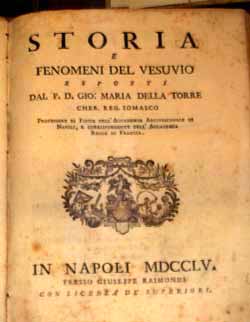 Maybe
they are trying to tell us something. There are 19 towns in the area
around Vesuvius known as the "Red Zone". That is the area that will
have to be evacuated in case of an eruption. There are about 600,000
persons living in the Red Zone. The communities at risk are now prepared
to offer €25,000 (about $30,000) towards a new place to live to
anyone who leaves the area. They call it Project Exodus and the hope
is that the project will reduce the population by one-third.
Maybe
they are trying to tell us something. There are 19 towns in the area
around Vesuvius known as the "Red Zone". That is the area that will
have to be evacuated in case of an eruption. There are about 600,000
persons living in the Red Zone. The communities at risk are now prepared
to offer €25,000 (about $30,000) towards a new place to live to
anyone who leaves the area. They call it Project Exodus and the hope
is that the project will reduce the population by one-third.
The "to
anyone" details are not at all clear. No one seems to know whether it
applies, say, to all family members in the same house or apartment—almost
certainly not the case—or if it even applies to those who rent
as opposed to those who own. It probably means that a single sum will
go to a single owner. I suspect that there will not be many takers.
Those who buy property around a volcano—at least in Naples—are
characteristically fatalistic about the future; you might be tempting
providence by taking the money. ("Oh, trying to pull a fast one, eh?
Where's my thunderbolt.")
Death, culture of
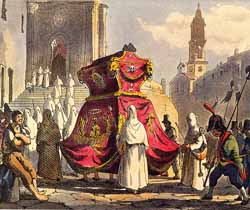 One
of those things that seem to happen only in films about Naples
actually happened yesterday. Fortunato Iorio is 30 years old, the father
of three children and has been unemployed for months. In January he
started underscoring his plight by displaying himself dressed in full
funereal garb, laid out in a coffin, and surrounded by flowers, his
faithful dog, and by weeping "mourners"—his friends and relatives
sympathetic to his situation. He lies there and they wail and keen slogans
such as "He might as well be dead without a job". Fortunato has even
founded an organization called Principle and Dignity, dedicated to helping
those in his same situation.
One
of those things that seem to happen only in films about Naples
actually happened yesterday. Fortunato Iorio is 30 years old, the father
of three children and has been unemployed for months. In January he
started underscoring his plight by displaying himself dressed in full
funereal garb, laid out in a coffin, and surrounded by flowers, his
faithful dog, and by weeping "mourners"—his friends and relatives
sympathetic to his situation. He lies there and they wail and keen slogans
such as "He might as well be dead without a job". Fortunato has even
founded an organization called Principle and Dignity, dedicated to helping
those in his same situation.
He was
on display again yesterday in downtown Naples, being carried along,
dead as a live doornail, by his pallbearer pals when they ran into a
real funeral procession. Fortunato did the right thing, of course,
which was to sit upright and make a respectful genuflection in the direction
of the real thing, after which he died back down again. The incident
was not reported as having caused any harsh words to pass from the direction
of the truly bereft. That may be—as I note in another entry—due to the often less-than-serious
view of death in Naples. There is often an air of perfunctory tragedy
about it.
university (1)
The main building of the University of Naples is on Corso Umberto,
one block east of Piazza Borsa. The building was erected between
1897 and 1908 as part of the massive urban
renewal of that portion of the city, which saw the construction
of the main boulevard, itself.
Officially, the university is named for Frederick II of Swabia, the Holy Roman Emperor, who founded the university in the thirteenth century. It is, thus, one of the oldest such institutions in Europe. Originally, the premises of the university were at the nearby church of San Domenico Maggiore. This was at the time when Thomas Aquinas (1225-74) taught theology there. The University was moved in 1615 to the building that now houses the National Museum. It moved from there to its present location off of Corso Umberto in 1777, moving into what had been a Jesuit monastery and college. That structure was the Chiostro del Salvatore, built in the late 1500s. The main university building on Corso Umberto is simply a front for that older building behind it, which now houses the university library. [More on other ex-monasteries.]
The entire
complex is vast, stretching up the hill towards Piazza San
Domenico Maggiore; it is one modern city block wide, as well, and
includes the university library and a number of museums of natural history.
Near the main building, across Corso Umberto, the University
has additional space in the ex-monastery of San Pietro Martire, originally
a Dominican establishment until closed in 1808. That two-level monastery,
built in 1590, was entirely restored in 1979.
Abu Tabela
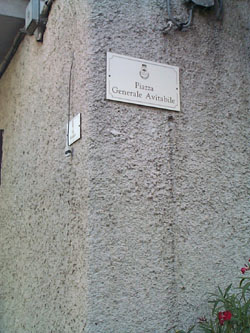 I
see that there is a bed and breakfast organization near the Amalfi coast.
That is not surprising, nor is the fact they advertise quaint little
hikes into the very beautiful surrounding countryside, some of them
quite close to the Fjord of Furore. One such hike
that caught my eye was billed as "Along the trail of Abu Tabela". The
blurb says, "…our goal is the small town square of San Lazzaro."
It praises the "blessed peace and quiet" of the area. (The town square
of San Lazzaro [photo], above the Amalfi coast, is still named for "General
Avitabile", hometown hero famous in Afghan lore as "Abu Tabela".)
I
see that there is a bed and breakfast organization near the Amalfi coast.
That is not surprising, nor is the fact they advertise quaint little
hikes into the very beautiful surrounding countryside, some of them
quite close to the Fjord of Furore. One such hike
that caught my eye was billed as "Along the trail of Abu Tabela". The
blurb says, "…our goal is the small town square of San Lazzaro."
It praises the "blessed peace and quiet" of the area. (The town square
of San Lazzaro [photo], above the Amalfi coast, is still named for "General
Avitabile", hometown hero famous in Afghan lore as "Abu Tabela".)
As it turns out, Abu Tabela was anything but quaint—and his life has very little to do with peace and quite, either, except the sombre peace and quiet brought on by death. He is the subject of a recent book by Stefano Malatesta entitled Abu Tabela, The Neapolitan Who Tamed the Afghans. If you are attracted by stories of Attila the Hun and Vlad the Impaler, you will like Abu Tamela, born Paolo Crescenzo Martino Avitabile in 1791 in the mountains above Amalfi in the then Bourbon Kingdom of Naples. How "Avitabile" turned into "Abu Tabela" and why that latter name is still used by mothers in Peshawar (in modern-day Pakistan) almost two centuries after the fact to control unruly children ("If you don't stop shut up, I'm going to call Abu Tabela")—that is a strange story.
At the age of 16, Avitabile enlisted in the Bourbon army. He soon passed into the new Neapolitan army of Gioacchino Murat, who had been made King of Naples by his brother-in-law, Napoleon Bonaparte, after the royal family fled to Sicily. When Napoleon's time had come and gone, Avitabile returned to service with the restored Bourbon military.
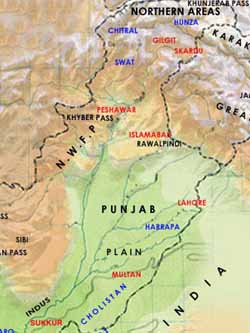 In
the early 1820s, however, he set out for parts east as a soldier of
fortune. He sold his services to the Shah of Persia and was apparently
successful in forcing the Kurdish population to pay their taxes. Then
in the late 1820s, when the great Sikh warrior Ranjit Singh captured
Peshawar (map, left), Avitabile went to work up there, right near the
infamous Khyber Pass, that beautiful vantage point and dead-end street
for many an invader of the Indian sub-continent. One of the stories
they tell about Singh is that despite his many conquests, he did not
allow wanton destruction of life or property, and that throughout his
life he never passed a sentence of death. I am unable to reconcile that
benign image with his employing a cut-throat such as Avitabile (local
pronunciation changed that to "Abu Tabela") as the govenor of the city
of Peshawar. Avitabile quickly earned the reputation of being a bloodthirsty
and ruthless enforcer of Sikh authority. Every morning, they say, Avitabile
would have a few Muslims thrown to their deaths from a minaret just
as a warning to the locals. He meted out absolutely gruesome "justice"
as governor of Peshawar, something that no doubt helped to drive the
population away from the city; the population of Peshawar was reduced
by half in the years of Sikh rule.
In
the early 1820s, however, he set out for parts east as a soldier of
fortune. He sold his services to the Shah of Persia and was apparently
successful in forcing the Kurdish population to pay their taxes. Then
in the late 1820s, when the great Sikh warrior Ranjit Singh captured
Peshawar (map, left), Avitabile went to work up there, right near the
infamous Khyber Pass, that beautiful vantage point and dead-end street
for many an invader of the Indian sub-continent. One of the stories
they tell about Singh is that despite his many conquests, he did not
allow wanton destruction of life or property, and that throughout his
life he never passed a sentence of death. I am unable to reconcile that
benign image with his employing a cut-throat such as Avitabile (local
pronunciation changed that to "Abu Tabela") as the govenor of the city
of Peshawar. Avitabile quickly earned the reputation of being a bloodthirsty
and ruthless enforcer of Sikh authority. Every morning, they say, Avitabile
would have a few Muslims thrown to their deaths from a minaret just
as a warning to the locals. He meted out absolutely gruesome "justice"
as governor of Peshawar, something that no doubt helped to drive the
population away from the city; the population of Peshawar was reduced
by half in the years of Sikh rule.
Avitabile got rich in Peshawar and, unlike many European soldiers-of-fortune in Asia, he had saved his money. He returned to Italy in the early 1840s. On the way back, he stopped for a while in England, where he was received by none other than Arthur Wellesley, Duke of Wellington (1769-1852). (Between 1845 and 1849, the British would fight two so-called "Sikh Wars," campaigns that led to the conquest and annexation of the Punjab into British India. Perhaps the Duke was eager for details from one who had "tamed" the Afghans. (Hmmm. Sound familiar?)
Abu Tabela
then went home to the hills of Amalfi, where he bought himself a nice
place to live and married a woman much younger than himself. She and
her lover—one of the servants— poisoned Avitabile in 1850.
It probably happened in one of those quaint little Bed and Breakfast
places, too.
Nunziatella
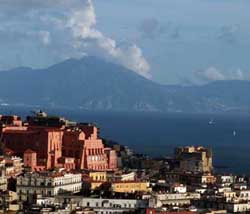 The military college Nunziatella is the prominent red building
that sits over the bay of Naples and that part of town known as Chiaia.
It was founded by Ferdinand IV in 1787 as an academy to train the officer
corps for the Kingdom of Naples. Originally, the building was erected
in 1588 by Anna Mendozza Marchesana della Valle, a noblewoman who then
gave the building to the Jesuit Order. The premises served as a novitiate
until the Jesuits were banned from the kingdom in the mid-1700s.
The military college Nunziatella is the prominent red building
that sits over the bay of Naples and that part of town known as Chiaia.
It was founded by Ferdinand IV in 1787 as an academy to train the officer
corps for the Kingdom of Naples. Originally, the building was erected
in 1588 by Anna Mendozza Marchesana della Valle, a noblewoman who then
gave the building to the Jesuit Order. The premises served as a novitiate
until the Jesuits were banned from the kingdom in the mid-1700s.
Shortly after its founding, students and faculty of the Nunziatella (so named for the chapel annex on the grounds of the academy—literally, "Little Church of the Annunciation") overwhelmingly supported the fledgeling and short-lived Parthenopean Republic. However, the revolution in France had, by that time, already devoured its children and the Neapolitan equivalent fared no better. The monarchy was restored and the Nunziatella was punished for its revolutionary fervor by a temporary demotion to the role of boarding school.
A far greater—ultimately fatal—danger to the Kingdom arose half a century later when the spirit of Italian unification swept the peninsula. Like all conflicts of this kind —close cousins to civil wars—this one commanded fierce and divided loyalties. In Naples, officer graduates of the Nunziatella were torn between fighting for their King and siding with the forces of Giuseppe Garibaldi, inexorably moving up the boot of Italy from their landing in Sicily with the truly revolutionary idea of one nation, united from the Ionian Sea to the Alps.
With unification came an inevitable decline of the agencies of the former Kingdom of Two Sicilies, now merely the southern half of a single greater nation. This decline took its toll on theNunziatella, which became, and has remained ever since, not the one academy responsible for turning out officers for the Kingdom—later, Republic—of Italy, but, rather, a respected military preparatory school.
In 1908,
amid all the tradition, the Nunziatella took the innovative step
of permitting, even encouraging, young graduates to pursue careers other
than military. The school thus established itself—and today, still
sees itself—as a well-spring of values important in all walks
of life. The most famous student ever to attend La Nunziatella was,
no doubt, King Victor Emmanuel III. It is, however, the lesser known
graduates —the doctors, lawyers and, of course, officers—who
remain the great source of pride for the Nunziatella.
Solfatara, Totò (2)
One of my favorite Totò films
is "47, Morto che parla" (47, Dead Man Talking). The title has to do
with the smorfia, the tradition of interpreting
dreams, of associating numbers with certain things in dreams and then
playing those numbers in the lottery. The presumption is that someone
on "the other side" is giving you a hot tip. Number 47 in the Smorfia
is Dead Man Talking, so if you have a dream in which you are conversing
with, say, one of your dearly departed, 47 is one number you should
play. Unfortunately, you need at least three "hits" to have any chance
of making real money. That's three friends in very high places—perhaps
too much to ask in any one week.
The film was made in 1950 and is a loose adaptation of a stage comedy of the same name by Roman playwright, Ettore Petrolini (1886-1936) with some of Moliere's The Miser thrown in. The whole plot revolves around getting a skinflint Baron, played by Totò, to reveal where he keeps a large stash of money. The conspirators figure that the best way to do this is to make Totò believe he is dead, have him wake up in the afterlife, and then get him to talk about what he did in life and where he hid things such as money. They drug him and cart him away to a Stygian landscape replete with fumaroles and other Dantean special effects; when he comes to his senses, those who were his friends in life are standing around in bed sheets and laurel wreaths, moaning and otherwise impersonating characters whom you might expect to meet in the doom and gloom antechamber of the hereafter.
I won't spoil the rest of the film for you, but I remember being taken with the set for the scene where he wakes up: barren hillside, lots of rocks, smoke and steam. It turns out that it was filmed on location in Naples— right outside of Naples, really, in the Solfatara, a very active and bubbling sulphur pit. It is located in the area known as the Campi Flegrei. Indeed, Petronius, in The Satyricon reminds us…
| Est
locus exciso penitus demersus hiatu Parthenopen inter magnaeque Dicarchidos arva, Cocyti perfusus aqua… (Satyr., CXX, 67-9) …that between Neapolis and the vast fields of Dicearchia [modern–day Pozzuoli] there is a place at the bottom of a cavern washed by the waters of the Cocytus*... [*One of the four mythological rivers of the netherworld, on the shores of which wandered the souls of those who had known no proper burial at death.] |
Strabo (66 B.C. -24 A.D.) also mentions the Solfatara in his Strabonis geographica, calling it Forum Vulcani, the abode of the god, Vulcan, and the entrance to Hades.
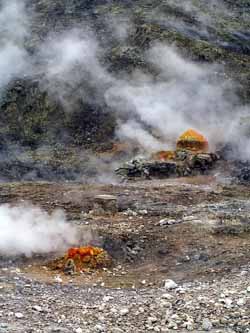 The
Solfatara is, at present, a protected nature reserve open to tourism.
It is, indeed, at the "bottom of a cavern"—a large crater of volcanic
origin and one that is still very active, geologically. In its long
history, the Solfatara has suffered from benign neglect as well as commercial
exploitation, having been mined for is alum and chalk as well as serving
as a source for mineral water with reputed medicinal value. Its value
as a scientific station for the study of the geologically very interesting
activity in the area started in 1861 when the property was purchased
by the De Luca family, which included Francesco De Luca, a physicist.
His scientific descriptions of the area, the mineral content of the
soil and waters, etc. are still informative reading. The area was officially
opened to visitors in 1900 but had long been—bound as it is to
Greek and Roman Mythology—a stop on the so-called "Grand
Tour".
The
Solfatara is, at present, a protected nature reserve open to tourism.
It is, indeed, at the "bottom of a cavern"—a large crater of volcanic
origin and one that is still very active, geologically. In its long
history, the Solfatara has suffered from benign neglect as well as commercial
exploitation, having been mined for is alum and chalk as well as serving
as a source for mineral water with reputed medicinal value. Its value
as a scientific station for the study of the geologically very interesting
activity in the area started in 1861 when the property was purchased
by the De Luca family, which included Francesco De Luca, a physicist.
His scientific descriptions of the area, the mineral content of the
soil and waters, etc. are still informative reading. The area was officially
opened to visitors in 1900 but had long been—bound as it is to
Greek and Roman Mythology—a stop on the so-called "Grand
Tour".
There have
been a number of recent documentaries on Italian national TV about the
Solfatara. They refer to the site as an "active volcano" and have used
it—with nearby Vesuvius, of course—as a point of departure
to discuss the geology of the entire Bay of
Naples.
NapoliMania
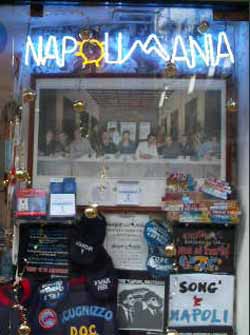 Five
years ago, Enrico Durazzo opened a shop called "NapoliMania". By now,
the enterprise has grown into a chain of eight shops throughout the
city, more than 30 in the entire Campania region, one in Rome and one
in Milan. They are what we might call "novelty shops"—t-shirts,
beverage mugs, coasters, pictures, and assorted gizmos and—as
Italians now say in imported English—"gadgets". (Friends are always
asking me for a precise distinction between "gizmo," "gadget,"
"thingamajig," and "whatchamacallit". Who am I, Thomas Aquinas?)
Five
years ago, Enrico Durazzo opened a shop called "NapoliMania". By now,
the enterprise has grown into a chain of eight shops throughout the
city, more than 30 in the entire Campania region, one in Rome and one
in Milan. They are what we might call "novelty shops"—t-shirts,
beverage mugs, coasters, pictures, and assorted gizmos and—as
Italians now say in imported English—"gadgets". (Friends are always
asking me for a precise distinction between "gizmo," "gadget,"
"thingamajig," and "whatchamacallit". Who am I, Thomas Aquinas?)
Everything in the shop has to do with Naples: the t-shirts are emblazoned with slogans or proverbs written in Neapolitan dialect; there are pictures of Vesuvius and models of Pulcinella, etc. There is even an "Emergency Kit" for Neapolitans when they travel; the kit includes a sealed can of Neapolitan air and a small Neapolitan coffee machine replete with instructions from the great playwright, Eduardo De Filippo, on how to prepare the only cup of coffee worth drinking. This is important, because when you get as far north as, say, Rome, Lord knows you sure can't drink that swill they make up there.
NapoliMania capitalizes on the abundance of well-known Neapolitans in show business. There is a painting that reproduces the main facade of the Royal Palace. In the 1880s the facade was adorned with eight statues depicting the first monarch of each dynasty that has ruled Naples since the 12th century, from Roger the Norman to the first king of united Italy, Victor Emmanuel II. The NapoliMania rendition has superimposed the heads of Totò, Eduardo De Filippo, Massimo Troisi, and others on the statues. The row includes Diego Maradona, an Argentine, but, for all practical purposes, as Neapolitan as they come, since it was he who led the powerhouse Naples soccer team of the 1980s.
Along that
line is, perhaps, their most popular item: Leonardo's The Last Supper
with Neapolitan celebrities at the table. At the center, in place of
Christ, is Sophia Loren. (I have not inquired of the artist --Durazzo,
himself-- why he made that particular choice, nor have I asked Sophia
how she feels about the honor.) It is more intriguing to see who is
cast in the role of Judas. Traditionally, Judas is thought to be fourth
from the left in Leonardo's painting. In the NapoliMania version, that
person is standing in back of the table, facing to his left. It is actor
Carlo Giuffrè. (Again, I haven't asked.) The others are comic
Totò, three members of the theatrical family of De Filippo (brothers
Eduardo and Peppino, as well as Eduardo's son Luca), Vittorio De Sica,
comic Massimo Troisi, contemporary singer-songwriter Pino Daniele, actor
Nino Taranto and singer Massimo Ranieri. Two of the twelve disciples
are the Neapolitan mask figure, Pulcinella, and the traditional
figure of the Neapolitan street-crier, the Pazzariello,
the character dressed in mock military garb who—until well
into the 20th century—used to parade around the streets
shouting out advertising for shops and services. Sophia Loren is the
only woman in the painting.
Bookshops, libraries (2)
 The
paper reports on a poll conducted by ALL (Adult Literacy and Life Skills)
that says 73% of those interviewed in the Naples area had never been
in a library and 45% had never set foot in a book–shop. The numbers,
so says the report, are particularly grim when it comes to the 16–31
age group, those who are about to leave school or who have recently
left school. They do not seem to have picked up the reading habit in
their studies.
The
paper reports on a poll conducted by ALL (Adult Literacy and Life Skills)
that says 73% of those interviewed in the Naples area had never been
in a library and 45% had never set foot in a book–shop. The numbers,
so says the report, are particularly grim when it comes to the 16–31
age group, those who are about to leave school or who have recently
left school. They do not seem to have picked up the reading habit in
their studies.
I am not sure how to interpret numbers like that. I have lamented in another entry the fact that there is no public library system to speak of in Naples. It is simply not part of the cultural history of the area. There is an extensive system of private libraries usually going back to prominent persons in the intellectual history of Naples. That is, for example, if you want to browse in what used to be Benedetto Croce's private library, you can do that at the institute founded in his name, where all his books now reside (see number 5 on map page). That pattern is repeated throughout the city. Getting into these places is a bit iffy, at times. It's almost like a Prohibition speak-easy—the knock on the door, the peep-hole, the panel sliding back, Joe the Bouncer asking you what you want, the password and countersign (maybe something like a whispered "Fahrenheit 451," and "Equals Centigrade 233". That's close enough; you might get in). Many important collections of books have also found their way into the National Library of Naples or one of the many university libraries in the city. The National Library is open to the public, but it is somewhat like the Library of Congress in the United States—browse, read, yes, but take home, no. The university libraries are along the same lines. The nice little public library down on the corner that issues you your free pass to lifelong learning does not exist.
Bookshops are another matter. There is a street in the historic center of Naples called via San Biagio dei librai—"Saint Biagio of the book sellers". (Saint Biago was a 17th-century monk ordained in Naples. I was hoping that he might turn out to be the patron saint of booksellers. That appears not to be the case; that honor goes to, among others, John the Apostle and Thomas Aquinas, the later of whom used to teach on the "book street". Pretty stiff competition for poor Biagio. Anyway…). The street still features a great number of small bookshops, usually dealing in old or even antique books. It also runs right through the university section of Naples, and there is a corresponding spike in the bookshop curve as you get to Piazza San Domenico Maggiore. Interesting, however, is the great number of sidewalk bookstalls that probably don't fit in a pollster's definition of "book shop" but do brisk business. Also, the street that runs from Piazza Dante to Port'Alba has at least a dozen bookshops along 75 yards of street. Many of these are used books stores that advertise prominently, "We buy books".
The Barnes
and Noble syndrome—the book supershop that, besides books, also
has CDs, DVDs, many other fine acronyms, a coffee shop and places to
sit and read—has come to Naples. There are two Feltrinelli stores
in Naples. They fit the above description, especially the newer of the
two (photo) at Piazza dei Martiri. A new wrinkle in town is the recent
opening of FNAC, originally a French chain, in the Vomero section of
town. It has all of the above and, as well, a computer section and Internet
cafe. They tell me that the shop in Paris has seven floors. In Naples,
it has but two, but with the business they seem to be doing, they may
have to invade the rest of the block.
Risanamento (3); Serao, Matilde (2); urbanology (5)
The last
sentence in the entry about the Risanamento, about the urban renewal of
Naples in the late 19th- and early 20th century, is this:
| It is a sad irony that the Risanamento of Naples coincided almost exactly with the period of greatest emigration away from Naples by the very persons who, at least on paper, were to have benefited from the rejuvenation of their city. |
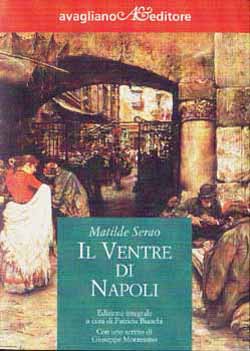 I certainly would have written that differently if I had thought
more about it. The fact of the matter is that the connection between
the Risanamento and massive emigration was not a coincidence—it
was cause and effect.
I certainly would have written that differently if I had thought
more about it. The fact of the matter is that the connection between
the Risanamento and massive emigration was not a coincidence—it
was cause and effect. Somewhere in the back of my head, I think I knew that large numbers of people had had to pick up and move when the project to rebuild Naples started in the 1880s. Then I heard someone mention the other day that "half the population of the city was displaced". That comes out to hundreds of thousands of people. They either moved to state-built shanty towns hastily cobbled together for the duration of the project (30 years), or they moved in with relatives or friends outside the affected area—or they left Italy. Thus, the Risanamento was largely responsible for massive emigration to the New World; they didn't just happen to coincide.
I was again made aware of the enormity of the project the other day by looking at a map of the area of Santa Lucia before the Risanamento and one of the same area after it had been rebuilt. The project changed the entire coastline of the city from Mergellina to the main harbor—well over a mile. The beautiful new sea-side road, via Caracciolo, from Mergellina to the center of town was, perhaps, necessary, and it looks fine today. Yet when they extended that road along the coast to make it the new road into town and lined it with high hotels, they (1) hid from view the original height of Pizzofalcone, the cliff across from Castel dell'Ovo (the hotels are higher than the cliff), and (2) relegated the historical sea-side road, via Santa Lucia, to the role of a secondary road running behind the hotels. That part of the Risanamento, alone, involved the construction of 15-20 blocks of buildings built on landfill in the original waters of Santa Lucia.
When Agostino Depretis (1813-87) was the head of the Italian government in the early 1880s, he used the phrase, "Bisgona sventrare Napoli"—Naples must be gutted. It was a bad choice of words. Another translation might prefer "disembowelled," but, either way, it's a violent metaphor. That is the phrase that stuck in the craw of those who were, if not totally against the Risanamento, at least very circumspect in their approach to solving the problems of overcrowding and disease, both of which were undeniable facts of life in the Naples of the 1880s. On the other hand, these critics weren't too happy with the state-coined euphemism, Risanamento, either—which means, literally, "Making Healthy Again".
The project, for better or worse, went ahead. Matilde Serao used Depretis' infelicitous phrase in the title of her book, Il ventre di Napoli (The Bowels of Naples). The book first appeared in serial form in nine installments in a newspaper in Rome, where Serao was living in 1884. In August and September of that year, Naples suffered its fifth and worst cholera epidemic in the 25 years since its incorporation into united Italy. The death toll was 7,000, and Prime Minister Depretis was convinced that the overcrowded and filthy center of Naples simply had to be torn down, aired out, and cleaned up (with a modern sewage system, among other things). The first chapter of Serao's book is in the form of a letter to Depretis, taking him to task for not really understanding Naples and its problems. Did he really think that building a few new streets was going to fix the problems of a city where poverty is so endemic that an entire family lives in one room—where they are born, where they eat, sleep, and die in a single room? In 1904, 20 years after the project started, and at a time when much of the Risanamento had either been completed or was in various stages of completion, Serao damned it with faint praise—the new university building is nice, she said.
[Also
see here.]
Gravina (palazzo)
One of the most impressive examples of Renaissance architecture
in Naples is the Palazzo Orsini di Gravina, located 100 yards north
of the main post-office and directly across the street from the statue
of the last Hapsburg King of Spain, Charles II (known as "Il Reuccio"
—the Little King). The original building was
erected between 1513 and 1549 by Gabriele d’Angelo along lines
dictated by the Florentine Renaissance. It was commissioned by and named
for Ferdinando Orsini, Duke of Gravina. Much of the external decorative
masonry was destroyed in a fire in 1848. Restoration, however, respected
the original Renaissance ideas of the designer. There are niches in
the facade, each containing a bust of a member of the Orsini family.
They are 19th century copies of the original 16th century works of Vittore
Ghiberti. Since 1936 Palazzo Gravina has housed the Architecture Department
of the University of Naples (see here).
Bourbons (7), (coat of arms)
Heraldry is the study of coats of arms. The "herald" was a medieval court officer responsible for maintaining records of coats of arms and titles of nobility. The emblems on a coat of arms were the individual's own distinctive marks; thus, the arms were the property of a person rather than of a government. Although coats of arms were originally used in battle for recognition of those otherwise unrecognizable (encased as they were in complete suits of armor), once introduced, the coats of arms were retained, even when displayed elsewhere. The widespread emergence of heraldry in the Middle Ages is associated with the Crusades and chivalric tournaments, which provided the opportunity for knights from all of Latin Christendom to come together as well as meeting the need to identify these knights on the battlefield and in tournaments.
The emblems used to mark an individual were various and might include animals, crosses, plants, letters, castles, and obscure symbols. Such emblems might be the individual's own emblem, one acquired through marriage, or an ancestral one; the emblems could show alliances or claims to fiefs and property rights; they often symbolized various honors bestowed upon the bearer or the bearer's ancestors and indicated various orders of which the bearer was a member; and, in some cases, the symbols represented historical events connected to the bearer's family history.
Although individual, the coats of arms, displayed on an appropriate flag, often came to symbolize the state, itself, as is the case with the coat of arms of the Kingdom of Naples, also known as The Kingdom of Two Sicilies. The Neapolitan branch of the House of Bourbon was the last dynasty to rule Naples before its incorporation into a united Italy. The Bourbons ruled from from 1735 to 1860, except during the Napoleonic interlude. The coat of arms of the Kingdom of Naples displays various historical connections between the Neapolitan Bourbons and other European nobility.
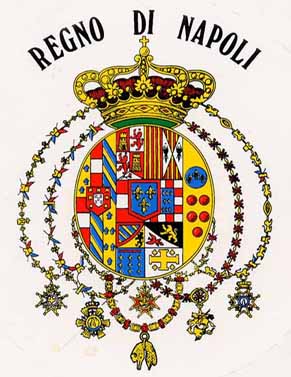 For purposes of this description and with intense apologies to
specialists, I shall dispense with the obscure vocabulary of heraldry.
Looking at the coat of arms, you see that the shield is divided, vertically,
into thirds. In the left third are the arms of Farnese consisting of
blue fleurs de lis on gold. This three-pointed stylized flower,
based on the lily was the symbol of the French Bourbon dynasty.
For purposes of this description and with intense apologies to
specialists, I shall dispense with the obscure vocabulary of heraldry.
Looking at the coat of arms, you see that the shield is divided, vertically,
into thirds. In the left third are the arms of Farnese consisting of
blue fleurs de lis on gold. This three-pointed stylized flower,
based on the lily was the symbol of the French Bourbon dynasty.
In the same third of the shield, Austrian connections are shown by the red-white-red horizontal stripes (still the flag of modern Austria, by the way); close-by are the blue and gold diagonal stripes of ancient Burgundy. In the middle of that third of the shield and imposed over the rest of the emblems are the arms of Portugal.
The center third of the shield is particularly complex. At the top, the "quartered" display on the left shows two segments with castles representing the Spanish house of Castile; the other two segments show lions for the House of Leon. At the bottom of that segment of the quarter, the small triangular section with a flower represents Granada. To the right of that quartered section are the four red poles on gold representing the House of Aragon; to the right is another "quarter" showing, again, two segments of Aragon and two of Sicily (a crowned black eagle).
In the middle of the center third of the shield, most prominent, are the arms of the House of Bourbon—three golden fleur de lis set on blue with a red border. These arms are imposed over the Austrian red-white-red on the left and the golden fleur de lis on blue with a red border of modern Burgundy.
The lower part of the center third is "quartered" and shows in the upper-left quarter the diagonal stripes of ancient Burgundy with the black lion on gold of Flanders; in the upper- right quarter are the golden lion on black of Brabant and the red eagle on silver of Tyrol; the lower-left quarter represents the Sicilian House of Anjou with golden fleurs de lis topped by a red lambel; the lower-right quarter shows the golden cross on silver of Jerusalem flanked by four other small crosses.
The right third of the shield is the simplest. It shows the arms of Medici: a gold field with five red balls and a blue upper bigger ball on which are displayed three golden fleurs de lis.
There are six orders displayed, hanging from the collars at the bottom of the coat of arms. From left to right they are:
·
the military order of King Francis I;
· the order of St. Ferdinand and of Merit;
· the order of St. Januarius (top center);
· the order of the Golden Fleece (center bottom—this
is among the oldest chivalric orders in Europe and was founded by Philip
III, Duke of Burgundy, at Bruges in Flanders in 1430, to commemorate
his wedding to Isabella of Portugal);
· the Constantinian Order of St. George;
· the Spanish Order of Charles III.
At the very top of the coat of arms, of course, is the royal crown. The crown is topped by a cross, representing the intense Catholic nature of the kingdom.
As might be expected of a coat of arms representing a dynasty founded by a Spanish prince (Charles III) of an originally French dynasty (Bourbon), this one is very Spanish and very French: heraldic symbols from Spain abound, and the Bourbon arms are at the center of everything. In terms of general design, its complexity is Spanish. The coat of arms has, however, a simpler side to it: it does not display "supporters" on the side—that is, human or animal figures on one or both sides of the shield, supporting it—nor does it display a helmet with or without a crest at the top, choosing, instead, to show the crown mounted directly on the shield. This simpler display was typical of French heraldry starting in the 18th century.
There is, indeed, a modern Bourbon pretender to the throne of Naples—Prince Ferdinand, Duke of Castro. He resides in France with his wife, the Duchess of Castro, the former Countess Chantal Frances de Chevron-Villette. There is even a Neo-Bourbon Society in Naples, which exists—according to their literature—not to restore the Kingdom of Naples, but to get southern Italians to appreciate their history. In 1999 they held a small demonstration in the historic center of the city to commemorate the Bourbon counter-revolution that defeated the Neapolitan Republic in 1799. More recently—and mundanely—they even held a Miss Kingdom of Two Sicilies beauty pageant!
Ironically, the modern Bourbons seem to get along quite amicably with the modern Savoys, the dynasty that defeated them in 1860 and that ruled Italy until deposed by popular referendum in 1946. The two houses give each other honors; the Duke of Castro has received the Order of the Annunciation of the House of Savoy, and the Duke of Savoy has received the Constantinian Order of Saint George of the House of Bourbon of Naples, as did his late father, King Humbert II. This friendliness should not be surprising in spite of the enmity between the two houses caused by the unification of Italy. Prior to that time, there were numerous episodes of intermarriage between the Bourbons of Naples and the Savoys, the most prominent of which was in 1832 when Ferdinand II of Naples married Cristina, daughter of Victor Emmanuel I, the Savoy monarch of Sardinia.
Also, see
the entries about Naples under the Bourbons: (1)
, (2) and (3)
as well as other the items "Bourbons" in the subject
index .
Ferdinando e Carolina (film)
 Among
light-hearted films about Naples, two of my favorites are still Vittorio
de Sica's La Baia di Napoli (1960) (English title: It Started
in Naples) with Clark Gable and Sophia Loren, and Billy Wilder's 1972
film with Jack Lemmon and Juliet Mills entitled Avanti. That
Italian word was the title in the original English-language release
of the film. It means, "forward," "go ahead," and "come in" and ran
through the film every time somebody knocked on a door, which was quite
often. One of the most amusing things about that delightful film was
that when it was released in Italy, they had to invent another Italian
title since Avanti also happens to be the name of the newspaper
of the Communist party of Italy. The revised Italian title came out
as the god-awful "What Happened Between My Father and your Mother".
Even a party slogan at every door-knock is better than that title.
Among
light-hearted films about Naples, two of my favorites are still Vittorio
de Sica's La Baia di Napoli (1960) (English title: It Started
in Naples) with Clark Gable and Sophia Loren, and Billy Wilder's 1972
film with Jack Lemmon and Juliet Mills entitled Avanti. That
Italian word was the title in the original English-language release
of the film. It means, "forward," "go ahead," and "come in" and ran
through the film every time somebody knocked on a door, which was quite
often. One of the most amusing things about that delightful film was
that when it was released in Italy, they had to invent another Italian
title since Avanti also happens to be the name of the newspaper
of the Communist party of Italy. The revised Italian title came out
as the god-awful "What Happened Between My Father and your Mother".
Even a party slogan at every door-knock is better than that title.
Last night I saw an interesting addition to the genre of light-hearted films about Naples: Ferdinando e Carolina, directed by Lina Wertmueller and released in 1999. It is, in Wertmueller's words, a "libertine comedy" about a very unfunny period in the history of the Kingdom of Naples, the period before the French Revolution when the young, oafish, and virile Ferdinand IV was running around the woods hunting while his very able wife, Caroline of Hapsburg, was making plans to run the kingdom. (See The Bourbons, Part 1.)
The story is told in a series of flashbacks running through the mind of Ferdinand on his death bed in 1825, after Napoleon had come and gone and after Carolina had died. He is tormented by the ghosts of his violent past, the liberals and Neapolitan revolutionaries he had had executed. In short, we see his youth, from fun-loving pseudo-urchin to fun-loving and vulgar young stud. It was enjoyable to watch. Like everything that Wertmueller does, Ferdinando e Carolina has that bit of Fellini and Zeffirelli about it, such that if you freeze almost any frame in the 102–minute running time, you have a frameable portrait, so perfect are the sets, costumes and choreography. Wertmueller points out that the shots of the inside of what was supposed to be the Bourbon Royal Palace were actually shot in the Savoy palace in Turin—a bit of "revenge" she says.
The film
featured Sergio Assisi as Ferdinando and Gabriella Pession as Carolina.
Assisi is a still relatively little-known actor. After the film was
released, he appeared at a book-signing in Naples with Giuseppe Campolieti,
the author of Il Re Lazzarone (roughly, the Beggar King), a recent
biography of Ferdinand. Assisi read passages from the book in Neapolitan
dialect. That was one of the charms of the film, too—much of it
was in the language of Naples, the only
language that the king ever really felt comfortable speaking. I don't
know anything about Gabriella Pession except that she either spoke—or
was dubbed (more likely)—with a thick German accent, all in keeping
with Queen Caroline's Austrian origins.
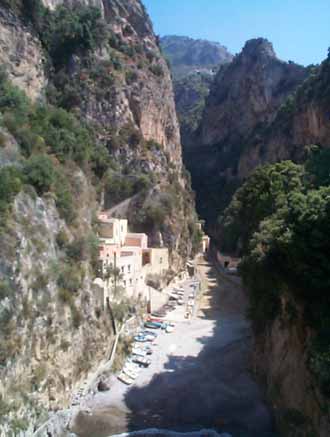 It's not really a fjord, though that is what they call it,
but, as a tree-hugging ecophile, I am happy to see that they are attempting
to restore this remarkable bit of terrain on the Amalfi coast.
It's not really a fjord, though that is what they call it,
but, as a tree-hugging ecophile, I am happy to see that they are attempting
to restore this remarkable bit of terrain on the Amalfi coast.
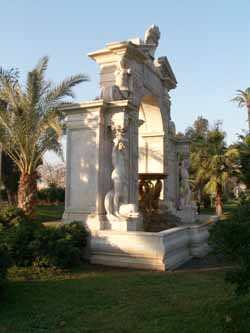 The
Villa Comunale houses the Anton Dohrn Aquarium (top photo). In
1870 Anton Dohrn (1840-1909), German zoologist and disciple of Darwin,
requested and got permission to build a “Zoological Station”
—an aquarium— in Naples. He was given a site within the
Villa Comunale and the project was begun in 1872 under Oscar Capocci
and finished by the German architect Adolf von Hildebrand. Interesting
artwork within the Florentine Renaissance building include murals by
the German artist Hans von Mareès, who drew inspiration from
characteristic fishing scenes of the Mediterranean, especially Naples
and Sorrento. Since its inception, the aquarium in Naples has not only
served as an exhibition of marine flora and fauna, but has also been
a working research facility in marine biology.
The
Villa Comunale houses the Anton Dohrn Aquarium (top photo). In
1870 Anton Dohrn (1840-1909), German zoologist and disciple of Darwin,
requested and got permission to build a “Zoological Station”
—an aquarium— in Naples. He was given a site within the
Villa Comunale and the project was begun in 1872 under Oscar Capocci
and finished by the German architect Adolf von Hildebrand. Interesting
artwork within the Florentine Renaissance building include murals by
the German artist Hans von Mareès, who drew inspiration from
characteristic fishing scenes of the Mediterranean, especially Naples
and Sorrento. Since its inception, the aquarium in Naples has not only
served as an exhibition of marine flora and fauna, but has also been
a working research facility in marine biology. 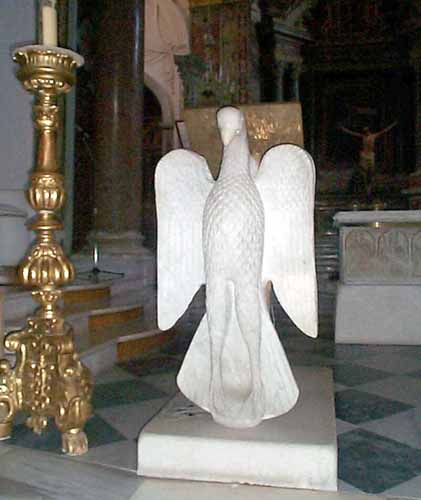 Even a cultural oaf such as myself is overwhelmed by the Amalfi
cathedral: The beautiful façade portraying Christ between the
symbols of the Evangelists, which, fittingly, gleams so brightly in
the noonday sun that you have to avert you eyes; the thousand-year-old
bronze doors from Constantinople; the Arab–inspired multihued
majolica tiles of the dome; an altar designed by the great Domenico
Fontana; the crypt containing the remains of St. Andrew (to whom the
cathedral is dedicated)—all of it is stunning. (Also see
Even a cultural oaf such as myself is overwhelmed by the Amalfi
cathedral: The beautiful façade portraying Christ between the
symbols of the Evangelists, which, fittingly, gleams so brightly in
the noonday sun that you have to avert you eyes; the thousand-year-old
bronze doors from Constantinople; the Arab–inspired multihued
majolica tiles of the dome; an altar designed by the great Domenico
Fontana; the crypt containing the remains of St. Andrew (to whom the
cathedral is dedicated)—all of it is stunning. (Also see